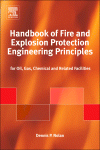Product desciption
Handbook Of Fire And Explosion Protection Engineering Principles For Oil Gas Chemical And Related Facilities Dennis P Nolan Auth by Dennis P. Nolan (auth.) 9781437778571, 1437778577 instant download after payment.
Content:
Front matter, Pages i-iii
Dedication, Page ii
Copyright, Page iv
Preface, Pages v-vi
About the Author, Page vii
1 - Introduction, Pages 1-11
2 - Overview of Oil and Gas Facilities, Pages 13-21
3 - Philosophy of Protection Principles, Pages 23-32
4 - Physical Properties of Hydrocarbons, Pages 33-48
5 - Characteristics of Hydrocarbon Releases, Fires, and Explosions, Pages 49-69
6 - Historical Survey of Fire and Explosions in the Hydrocarbon Industries, Pages 71-82
7 - Risk Analysis, Pages 83-90
8 - Segregation, Separation, and Arrangement, Pages 91-101
9 - Grading, Containment, and Drainage Systems, Pages 103-111
10 - Process Controls, Pages 113-118
11 - Emergency Shutdown, Pages 119-126
12 - Depressurization, Blowdown, and Venting, Pages 127-138
13 - Overpressure and Thermal Relief, Pages 139-143
14 - Control of Ignition Sources, Pages 145-155
15 - Elimination of Process Releases, Pages 157-161
16 - Fire and Explosion-Resistant Systems, Pages 163-179
17 - Fire and Gas Detection and Alarm Systems, Pages 181-201
18 - Evacuation, Pages 203-210
19 - Methods of Fire Suppression, Pages 211-242
20 - Special Locations, Facilities, and Equipment, Pages 243-255
21 - Human Factors and Ergonomic Considerations, Pages 257-266
Appendix A. Testing Firewater Systems, Page 267
A.1 - Testing of Firewater Pumping Systems, Pages 268-271
A.2 - Testing of Firewater Distribution Systems, Pages 272-275
A.3 - Testing of Sprinkler and Deluge Systems, Pages 276-277
A.4 - Testing of Foam Fire Suppression Systems, Page 278
A.5 - Testing of Firewater Hose Reels and Monitors, Pages 279-280
A.6 - Fire Protection Hydrostatic Testing Requirements, Page 281
Appendix B. Testing Firewater Systems, Page 283
B.1 - Fire Resistance Testing Standards, Pages 284-285
B.2 - Explosion and Fire Resistance Ratings, Pages 286-288
B.3 - National Electrical Manufacturers Association (NEMA) Classifications, Pages 289-294
B.4 - Hydraulic Data, Page 295
B.5 - Selected Conversion Factors, Pages 296-300
Acronym list, Pages 301-303
Glossary, Pages 304-310
Index, Pages 311-324


